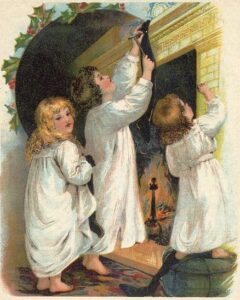
The stockings were hung by the chimney with care, in hopes that St. Nicholas soon would be there.
These often over-looked lines from Clement Clarke Moore’s famous poem about the night before Christmas raise at least two pertinent questions:
Who was St. Nicholas?
And, why does he need stockings?
The Real St. Nicholas
St. Nicholas was a 4th century Christian bishop, famous for serving the poor, leaving anonymous gifts and performing the occasional miracle. Orphaned at a young age, Nicholas became a monk and eventually rose to the rank of bishop.
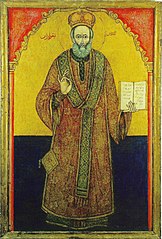
Nicholas died December 6, 343 and became the most popular saint in the pre-modern church. [Fun Fact: Only the Virgin Mary has more churches named after her than Saint Nicholas.] After the Protestant Reformation, saint’s days fell out of favor, but St. Nicholas remains popular, possibly because his saint’s day is December 6.
Nicholas has a large portfolio, filling the position of patron saint for sailors, merchants, archers, repentant thieves, prostitutes, brewers, pawnbrokers, unmarried persons, the nations of Russia and Greece, and various cities. Each of these beneficiary groups are associated with one or more of the saint’s miracles.
A Sampler of Miracles by St. Nicholas
A MIRACLE FOR SAILORS
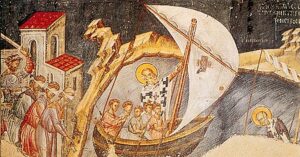
A ship in the eastern Mediterranean Sea was caught in a sudden storm, forced into shallow water and ran aground. The desperate sailors prayed for Nicholas to intervene. To their amazement, the saint personally appeared on the ship and helped the crew move the ship into deeper water. As soon as the boat stabilized, Nicholas disappeared.
Safely ashore, the crew found a church in Myra where they could thank God for their rescue. Imagine their surprise when they recognized Bishop Nicholas in the flesh.
When they asked how Nicholas knew their plight and was able to come to their rescue, Nicholas replied that if a man lives his life in devotion to God, he can see when someone is in danger and hear their cries for help.
A MIRACLE FOR UNMARRIED WOMEN, AKA THE MIRACLE OF THE THREE MAIDENS
According to Michael the Archimandrite’s Life of Saint Nicholas, Bishop Nicholas heard of a devout man who had fallen into a state of financial hardship that made it impossible for him to provide dowries for his three unmarried daughters.
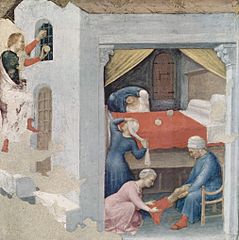
The girls could not marry without a dowry, and without a husband or other means of employment, they were at risk of falling into prostitution. Bishop Nicholas wanted to help the family, but he knew the father would not want to accept charity. Besides which, Nicholas didn’t want to call attention to himself.
One night under cover of darkness, Bishop Nicholas went to the house and threw a purse of gold coins through the window. The ecstatic father immediately arranged for the first daughter’s marriage.
After the wedding, Nicholas threw in a bag of coins for the second daughter. After she married, the father stayed awake for two nights to see if a third purse of coins would appear. When it did, the father fell onto his knees to thank Bishop Nicholas for his generosity. Nicholas accepted the man’s gratitude and ordered him not to tell anyone aout the gifts. Clearly, the story could not be kept quiet.
A MIRACLE FOR THE FALSELY ACCUSED
Michael the Archimandrite recorded the story of three men about to be unjustly executed. Before the executioner’s axe could fall, Bishop Nicholas arrived, struck off the men’s chains and proved their innocence by identifying the juror who accepted a bribe to condemn the men.
A MIRACLE TO PROTECT INNOCENT CHILDREN
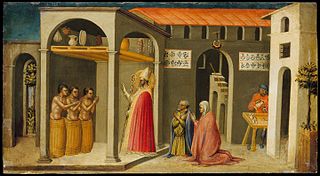
During a severe famine, an unscupulous butcher lured three children to his house and killed them. He then placed their remains in a pickling barrel to cure so he could sell the resulting product as ham. Bishop Nicholas came to the region to care for famine victims, saw through the butcher’s lies, made the sign of the cross over the barrel, and resurrected the children.
Modern Celebrations on St. Nicholas Day
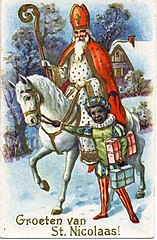
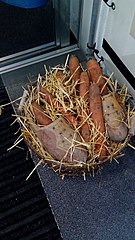
St. Nicholas day is December 6th. Annual St. Nicholas celebrations in the Netherlands begin the evening of December 5th with a family feast called Sinterklassavond. The menu includes Bishop’s wine, various breads, cookies shaped like St. Nicholas and a special main dish. In France a popular main dish is pork with mustard and applies; in Germany, Pfannkuchen [pancakes] are a popular choice.
In Belgium and the Netherlands a man dressed as St. Nicholas arrives on a ship and rides a white horse through town to hand out gifts. On St. Nicholas Eve, children put out shoes filled with carrots and hay for St. Nicholas’s horse, and hope he will leave gifts for them in the shoe.
Children can also leave a boot in front of the fireplace or an outside door so it can be filled with special treats. These might be chocolate candy with gold foil wrapping to represent coins. Mandarin oranges are also popular, because they look like gold.

The gifts, of course, are for the good children. St. Nicholas has a companion named Krampus who punishes naughty children. Krampus is a demon figure who is half-man and half-goat. He’s the one who puts coal in children’s shoes.
In Italy, unmarried women have a special church service for the rito delle nubili, a ritual in which young women turn a column seven times to improve their luck gaining a husband.
🧑🎄 🧑🎄 🧑🎄
Illustrations
Children Hanging Christmas Stockings, 1870.
St. Nicholas Icon. turn of 18th century.
Miracle of St. Nicholas in Sea, Fresco at St. Nicholas Orphanos Church. 14th century.
Dowry for the Three Virginia by Gentile de Fabriano.
St Nicholas Resuscitating Three Youths by Bicci di Lorenzo.
St. Nicholas & Helper.
Sinterklaas decorations in Winschoten Oldambt by Donald Trung Quoc Don.
Krampus by Anita Martinez.
Ashley Novak. “St. Nick May Have Inspired Santa.” The Good Stuff. CNN. Dec. 6, 2020.
Jillian Rodriguez. “Facts Behind Five St Nicholas Day Traditions.” Mango. Dec. 5, 2016.

Sandra Wagner-Wright holds the doctoral degree in history and taught women’s and global history at the University of Hawai`i. Sandra travels for her research, most recently to Salem, Massachusetts, the setting of her new Salem Stories series. She also enjoys traveling for new experiences. Recent trips include Antarctica and a river cruise on the Rhine from Amsterdam to Basel.
Sandra particularly likes writing about strong women who make a difference. She lives in Hilo, Hawai`i with her family and writes a blog relating to history, travel, and the idiosyncrasies of life.


Having arranged and described, decades ago now, the **mass** of papers involved in a proposal for sainthood, St. Nick’s “portfolio” 🙂 <3, must make Vatican archivists grateful for the modern dearth of polymath saints! Glorious post, thank you.
Thank you for taking the time to comment, Toni